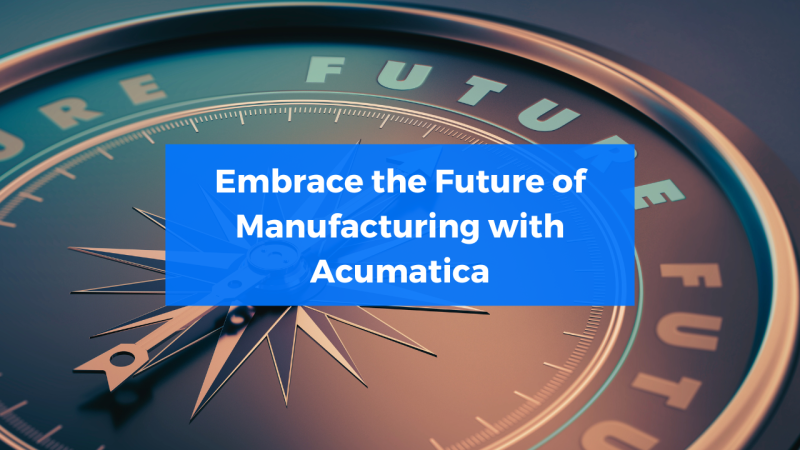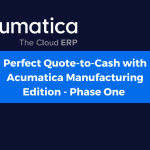Embrace the Future of Manufacturing with Acumatica
A Digital Transformation Guide for Forward-Thinking Manufacturers
MANUFACTURING TECHNOLOGIES AND TRENDS
Imagine a world where 3D printers create products in plastic and metal, batteries grow from viruses, and contact lenses zoom in with a blink. These breakthroughs highlight how essential technology is in both product design and business process management.
For manufacturers using outdated ERP systems or basic accounting software, modernizing factory operations is critical for staying competitive. Some may need to overhaul their systems or adopt costly bolt-on applications that lack seamless integration. This guide introduces key features of manufacturing ERP systems and offers strategies for connecting ERP software with the latest technologies, helping manufacturers future-proof their operations.
STEPS TO BUILDING A FUTURE-READY FACTORY
- FEATURES
- TECHNOLOGIES
- STRATEGY
- EXECUTION
KEY ERP FEATURES FOR MANUFACTURERS
There are eight essential categories to focus on when upgrading your systems: general features, accounting, order management, inventory, product design, production management, planning and scheduling, and analytics. These features streamline data entry, improve visibility, and integrate advanced technologies.
General Features: A modern factory demands innovative technology with cloud or on-premises options, strong security measures, customizable workflows, real-time inventory updates, and flexible units of measure conversions.
Order Management: Sales management should include embedded CRM, B2B/B2C integrations, and support for omnichannel returns. Key features include backorders, item substitutions, flexible pricing, vendor bidding, EDI integration, and logistics management.
Accounting: Support for local tax regulations, GAAP/IFRS standards, multicurrency transactions, and advanced features like payroll and intercompany accounting is essential. Look for automated bank feeds and mobile expense management.
Inventory Management: Seek ERP systems with native barcoding, flexible warehouse management, and tools for managing perishable goods (lot tracking, FEFO picking). Advanced delivery and route management capabilities are also beneficial.
Product Design: Modern CAD and PLM applications should integrate seamlessly with ERP systems to harmonize engineering and production processes, track compliance, and manage product lifecycles.
Production Management: The ERP should support real-time job costing and allow mobile devices for managing production order details and resource tracking.
Analytics & Reporting: Advanced reporting features, role-based dashboards, and business intelligence tools like Microsoft Power BI are critical for monitoring KPIs and ensuring visibility across all operations.
Planning & Scheduling: Utilise advanced scheduling algorithms and demand forecasting to optimize material purchases, inventory levels, and resource allocation.
FUTURE-FOCUSED MANUFACTURING TECHNOLOGIES
Prepare your ERP system for the future with low-code/no-code integrations and Open APIs. This allows easy automation and connection to cutting-edge manufacturing technologies such as:
- WMS, RFID, and IIOT
- Robotics, SCADA, PLC, and M2M
- Virtual/Augmented Reality (VR/AR)
- AI, Machine Learning, and Virtual Assistants
- Cybersecurity solutions like Blockchain
- Additive Manufacturing (3D Printing)
- Mobile and Wearable Technology
STRATEGY: STEPS TO DIGITAL TRANSFORMATION
Transforming your operations requires careful planning. Start by evaluating your current systems, identifying gaps, and setting a foundation for growth.
Step 1: Foundation
Begin by assessing your ERP system. If you’re using outdated software, upgrading or replacing it will streamline integration and reduce inefficiencies.
Step 2: Research
Conduct a detailed assessment of your manufacturing processes to identify functional gaps and areas for automation.
Step 3: Prioritize
Rank each modernization initiative based on cost and potential impact. Focus on high-priority projects that bring immediate benefits.
Step 4: Develop a Plan
Set clear goals, establish timelines, and document the technologies needed for implementation. Ensure your plan includes contingencies for unexpected challenges.
EXECUTION: IMPLEMENTING A MODERN WAREHOUSE
Once the plan is in place, it’s time to execute. Implement the new systems in four key phases: preparation, go-live, review, and continuous improvement.
Phase 1: Preparation
Begin by preparing well in advance of your go-live date. Assign project leads, conduct reviews, and establish contingency plans.
Phase 2: Go-Live
A successful go-live is organized and well-executed, with a designated project lead overseeing each step.
Phase 3: Review
After go-live, monitor the results, gather feedback, and fine-tune processes based on user input and performance data.
Phase 4: Continuous Improvement
Keep systems up-to-date, test upgrades in a sandbox environment, and look for ways to enhance automation and processes over time.
Make the Leap to Digital Transformation with Acumatica Manufacturing Edition
In today’s digital age, outdated systems hold manufacturers back, forcing them to rely on costly customizations and disjointed processes. Acumatica’s Manufacturing Edition provides the tools needed to automate operations, improve quality, and boost profits.
With a comprehensive suite of connected applications, manufacturers can streamline production, manage materials, plan and schedule resources, and configure products more effectively. Tailor Acumatica’s extensive capabilities to fit your unique manufacturing environment and build a future-proof platform for sustained growth.
Related Articles
-
- Maximise Your Tech Investment With Acumatica
- Revolutionise Your Distribution Business With Acumatica
- Acumatica Distribution Edition Overview
- Improve Inventory Management With Acumatica
- Unlock Valuable Business Insights With Acumatica
- Introducing Acumatica CRM
- Boost Growth Through Enhanced Manufacturing Efficiency
- Your Free Guide to Choosing a New ERP System
- What Is Cloud ERP?
- 5 Benefits of Cloud ERP
- How Acumatica Improves Lead Generation For Manufacturers
- 5 reasons to upgrade from Quickbooks to Acumatica.
Need more information? Get in touch with us now.






